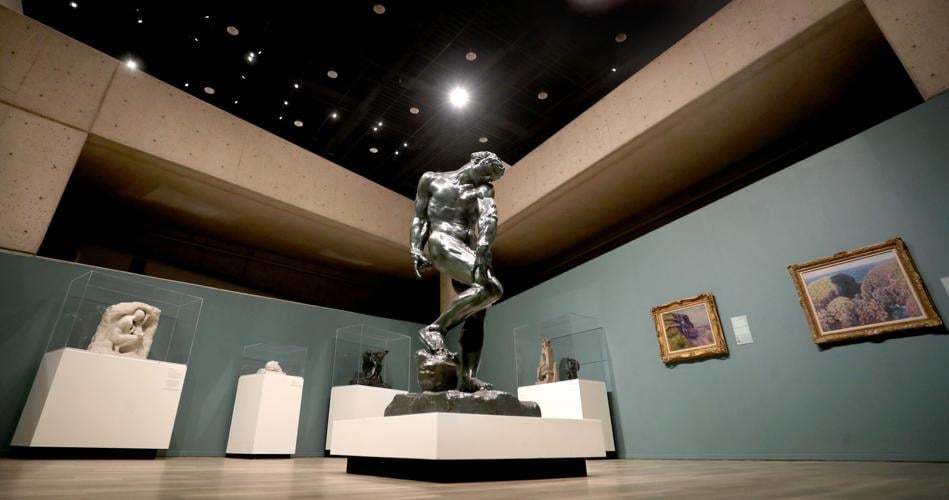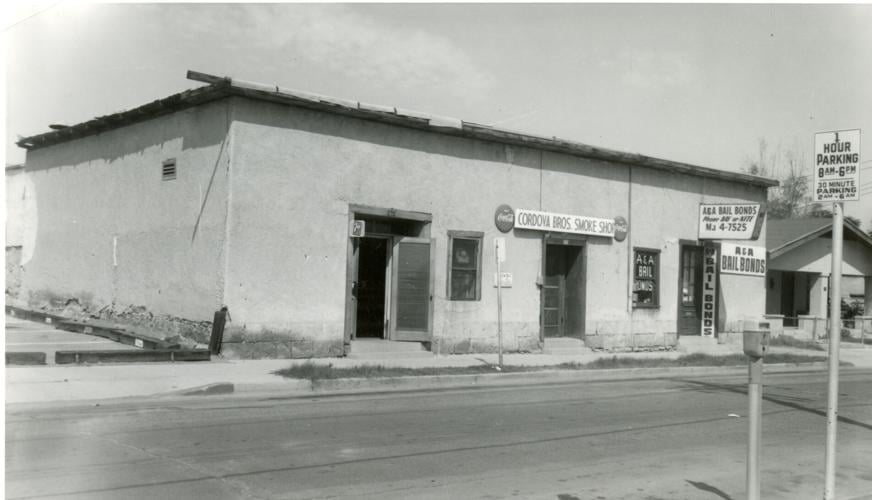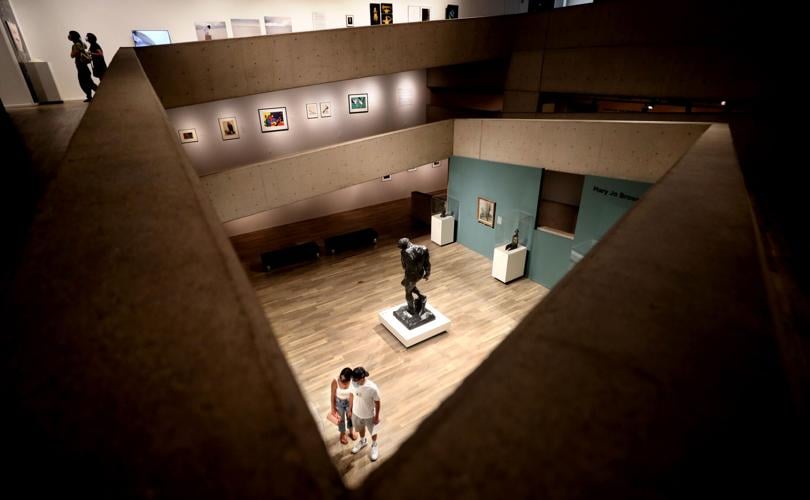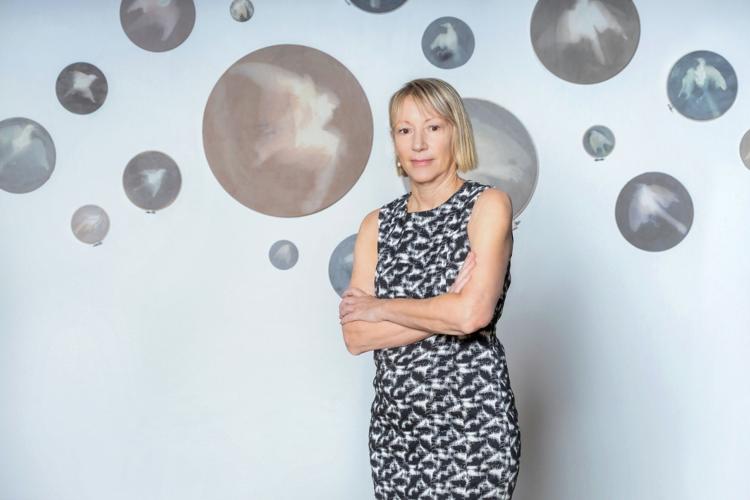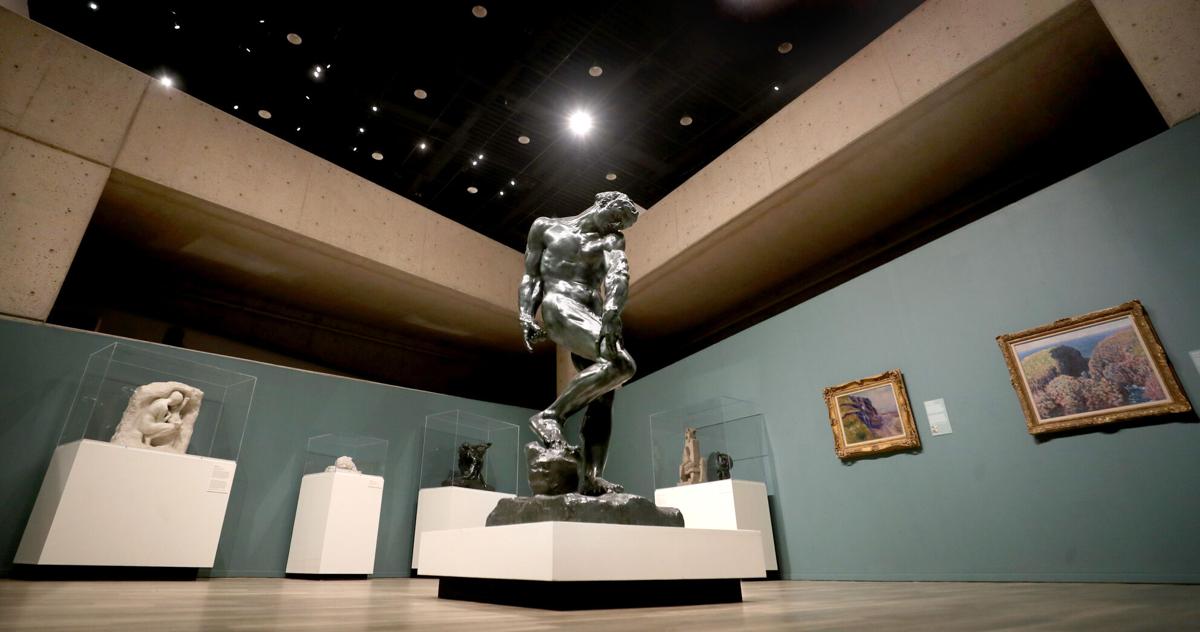An iconic art institution in Tucson is celebrating a milestone achievement this month — its centennial.
The Tucson Museum of Art, 140 N. Main Ave., officially turns 100 on March 20 and they’re honoring the accomplishment in big ways starting with a centennial gala and a new exhibition, followed by a block party later this year.
TMA’s Centennial Gala starts at 5 p.m. Saturday, March 16, followed by a dinner provided by Café à La C'Art. The $350 event includes cocktails, a silent auction and a first look at the new “Time Travelers: Foundations, Transformations, and Expansions at the Centennial” exhibition that honors art collected by the museum over the last 100 years.
The exhibition officially opens to the public on Sunday, March 17 and runs through Sunday, Oct. 6.

Visitors look over the art displayed on multiple levels at the Tucson Museum of Art where ramps lead to the lowermost galleries below ground level.
Over the years, the museum has been home to numerous pieces of artwork from local and nationally recognized artists. But for many, TMA has been more than an institution storing art — it’s a hidden gem that’s housed priceless moments, too.
TMA isn’t only celebrating 100 years of art, they’re celebrating...
🎨 100 years of artists discovering their place in the world as their work finds a home in the museum.
🚌 100 years of local children learning about various art styles during school field trips.
❤️ 100 years of lovers strolling the galleries during first dates.
🖼 100 years of people taking a moment to themselves to appreciate a piece of art in silence.
🌎 100 years of Tucsonans gaining new perspectives on the world around them.
“Our mission is to connect art to life, and we do that through offering meaningful and engaging experiences that inspire discovery and spark creativity,” says Norah Diedrich, the museum's Jon and Linda Ender Director and CEO. “And the third, which really hits home to me, is to promote cultural understanding. I really think that from the beginning, (with) this organization, it was really a mission and a desire to be a community-centered institution, to be responsive to the community and advocate for the community.”
A brief history of the Tucson Museum of Art and Historic Block

Clara Fish Roberts and Jennie Moses in front of Edward Nye Fish House, 1899. The Fish House is now home to the museum’s gift shop and rotating exhibitions.
Before TMA was the museum (and historic block) we know today, it used to look and sound a little different.
In the spring of 1924, “a meeting was called by Mrs. George Kitt, Alice P. Teasdale and Mrs. E. F. Harris, board members of the Art Section of the Woman’s Club, to discuss the creation of a permanent art organization in Tucson,” according to TMA’s website.
Following the women’s meeting on March 20, 1924, the Tucson Fine Arts Association was born.
“It was the TFAA at its beginnings and they were really community-minded individuals,” Diedrich says. “They also had other art enthusiasts and artists join them. And they felt so strongly that Tucson deserved to have a dedicated arts organization. And they did so very much and (were) really community supported. At the beginning, they didn't even have a dedicated space until the beautiful Temple of Music and Art opened in 1927 and the TFAA rented gallery space in that building, I believe up on the second floor. And out of a very small space, it’s quite outstanding what the organization was able to do.”
The next four decades brought name changes and new locations for the art organization and museum. In the 1940s, the Tucson Independent Artists Group, another local art organization, and TFAA merged into one, sharing the TFAA name. During this time, the Temple of Music and Art stopped its activities, pushing TFAA to utilize the local Chamber of Commerce building on South Stone Avenue for exhibition space, according to TMA’s website.
Throughout the first decades of its existence, TFAA partnered with many organizations to showcase the works of important 20th century artists.
“They partnered with the Corcoran Gallery of Art in Washington, D.C. and the Brooklyn Museum of Art,” Diedrich says. “TFAA partnered with the Chicago World's Fair, in 1933 it was called A Century of Progress International Exposition, and they showed work by Diego Rivera and Carlos Mérida. They had a solo show of Maynard Dixon at the Temple of Music and Art in 1941. They worked with the Farm Security Administration in 1942 and featured photographers such as Dorothea Lange, the iconic Walker Evans and Ben Shahn — these major names in the '50s and early '60s.
“TFAA partnered with the Whitney Museum of American Art, MoMA in New York and MoMA San Francisco. They exhibited Jackson Pollock, Elaine de Kooning, Richard Diebenkorn, Henry Moore, Pablo Picasso, Andy Warhol and it just goes on and on. … It's just absolutely outstanding that they were able to do that and this goes back to the early days in the '20s, '30s and '40s here in Tucson, I had no idea. It’s outstanding.”

The Tucson Art Center was located at 325 W. Franklin St.
By the late 1950s, TFAA moved into the home of former Judge Samuel Kingan at 325 W. Franklin St., after the Arizona Board of Regents approved the sale of the University of Arizona-owned property in October 1957, according to the Arizona Daily Star. The property is about one block north of TMA’s current location on North Main Avenue.
In the early 1960s, TFAA officially changed its name to the Tucson Art Center, also known as TAC. During the TAC days, the organization saw around 2,000 visitors each month, according to the Arizona Daily Star.
“They had an incredible art education program there at the time and that's when they really began to think about starting a permanent collection of work,” Diedrich says. “And that first piece was a beautiful and quite large lithograph from (Henri de) Toulouse-Lautrec. It's an 1895 print of La Revue Blanche and that was gifted to us as the first piece to come into our collection (in 1959).”

Cordova Brothers Smoke Shop and Abe’s Bail Bonds, pictured in the late 1960s. The Cordova House is on the National Register of Historic Places and is set to reopen to the public later this year, according to TMA’s website.
After being known as TAC for over a decade, the organization changed its name to the Tucson Museum of Art and Historic Block in 1975 after moving into its permanent (and current) home at 140 N. Main Ave. Its historic block features five of Tucson’s oldest homes including La Casa Cordova, Romero House, which currently houses the Romero House Potters ceramic studio, and the Fish House, which now houses the museum’s gift shop and rotating exhibitions.
During the museum’s public grand opening in May 1975, TMA had over 1,500 visitors check out the museum, according to an article by the Tucson Citizen in 1975.
“From then, we continued to grow and added a new wing and a beautiful art education center,” Diedrich says. “And today we have nearly 12,000 works of art in our collection. We continue to add new pieces to the collection every year. We have on average about 375 or so works of art every year. It's really, really growing and is 12,000 beautiful, important works of art, but it spans 3,000 years of history.”

Tucson Museum of Art during construction of the main building in 1974.
In recent years, the museum added the Kasser Family Wing of Latin American Art which honors art of the ancient Americas, according to TMA. The new wing debuted in 2020.
'I think we've been on the right track for 100 years.'
While TMA has been through numerous changes over the last 100 years, something that hasn’t changed is its dedication to community — whether that’s through partnerships with local organizations or simply sharing the wonders of fine art with locals and visitors.
Currently, TMA has several programs that help make art more accessible in the community. Many of these programs partner with local organizations and schools, such as its Museum As Sanctuary program for immigrants and refugees that began with Owl & Panther. Another program is a partnership with Davis Bilingual Elementary School, allowing students to visit TMA every Wednesday of the academic year.
TMA currently serves over 700 K-12 students every year, according to Diedrich.
The museum also works closely with the Alzheimer’s Association (Desert Southwest Chapter) and the Veteran Affairs’ Southwestern Blind Rehabilitation Center.

Judith Parker walks through the Kasser Family Wing of Latin American Art inside the Tucson Museum of Art.
To make art even more accessible to the general public, TMA offers two “pay what you can” days on the first Thursday and second Sunday of each month.
“I've heard this for the last year that we're sort of this hidden treasure, this hidden gem,” Diedrich says. “And I now carry free museum passes with me all the time because I'm always meeting people that either have just moved here or have lived here for a long time. And we start talking about what my job is and where I work in the museum and they don't know we're here. So, I give them a free pass. We have this treasure here and I want more people to know about it.”

Norah Diedrich, the Jon and Linda Ender Director and CEO of the Tucson Museum of Art.
Although Diedrich is fairly new to TMA after moving from Newport, Rhode Island to become TMA’s new CEO a little over a year ago, she says she feels “really happy to be here at this point in time.”
“I would like to see the museum continue to evolve and stay open-minded and carry on the initial community building (mission) the founders had way back in 1924,” she says. “Now, what that looks like, I don't know, but I think that if we continue to learn from that past and appreciate all that growing and learning and evolving that was done the past 100 years and if we can apply that to the future and really think about the entire (historic) block ... I would like to see us animate (the entire historic block) in a bigger way in the near future and years down the line. Nobody can guess what it'll look like but I think we've been on the right track for 100 years.”
For more information about the Tucson Museum of Art and its centennial, check out their website.


